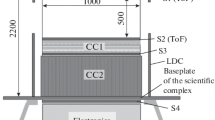Abstract
Gamma-rays emitted from the surfaces of atmosphere-free extraterrestrial bodies such as asteroids, planets, or moons, can be measured to determine their chemical surface composition. Gamma-rays are emitted from naturally radioactive elements and, in their majority, are induced by the interaction of the energetic galactic cosmic particle radiation. Neutrons of the secondary hadron cascade contribute considerably to the gamma-ray line surface fluxes via nonelastic scattering and neutron-capture reactions. In principle, planetary gamma-ray spectroscopy resembles laboratory applications of prompt activation techniques. However, the evaluation of an orbital gamma-ray spectrum of other bodies than the Moon is difficult, as comparisons to so-called “ground truth” values, which functioned as standards, are not possible. Future planetary exploration missions will require the evaluation of recorded gamma-ray spectra without such standards. Therefore, in an attempt to overcome some of these difficulties, prompt gamma-ray spectra of planetary constituents were measured in a set of laboratory experiments with neutron-generator and cyclotron produced neutrons of energies up to 78 MeV. The significance of neutron-capture and nonelastic scattering gamma-ray lines for the characterization of major elements were established, and the application of the results to planetary gamma-ray spectroscopy of asteroids is discussed.
Similar content being viewed by others
References
E. ANDERS, Phil. Trans. R. Soc. London, A285 (1977) 23.
H. WÄNKE, Phil. Trans. R. Soc. London, A303 (1981) 287.
J. R. ARNOLD, A. E. METZGER, R. C. REEDY, Proc. 8th Lunar Science Conf. 1977, p. 945.
R. C. REEDY, Proc. 9th Lunar Planetary Science Conf., 1978, p. 2961.
M. GARCIA-MUNOZ, J. A. SIMPSON, Proc. 16th Int. Conf. on Cosmic Rays, OG-6-3, 1979, p. 270.
J. R. JOKOPII, Rev. Geophys. Spa. Phys., 9 (1971) 27.
L. G. EVANS, J. I. TROMBKA, J. R. LAPIDES, D. H. JENSEN, IEEE Trans. Nucl. Sci., NS28 (1980) 1226.
M. R. WORMLAND, C. G. CLAYTON, J. Appl. Radiation Isotopes, 34 (1983) 71.
A. E. METZGER, J. I. TROMBKA, R. C. REEDY, J. R. ARNOLD, Proc. 5th Lunar Science Conf., 1974, p. 1067.
R. MICHEL, H. WEIGEL, K. KULUS, W. HERR, Radiochim. Acta, 21 (1974) 169.
P. ENGLERT, R. C. REEDY, R. FOX, J. R. ARNOLD, Meteoritics, 18 (1983) 294.
S. THEIS, P. ENGLERT, R. MICHEL, R. C. REEDY, and J. R. ARNOLD, Proc. 15th Lunar and Planetary Science Conf., 1984, p. 853.
R. E. LINGENFELTER, E. H. CANFIELD, V. E. HAMPEL, Earth Planet. Sci. Lett., 16 (1972) 355.
J. R. LAPIDES, Ph. D. Thesis, University of Maryland, USA, 1981.
J. BRÜCKNER, Dissertation, Universität zu Mainz, FRG, 1984.
J. BRÜCKNER, R. C. REEDY, H. WÄNKE, Proc. 15th Lunar and Planetary Science Conf., 1984, p. 98.
R. WÖLFLE, S. KHATUN, S. M. QUAIM, Nucl. Phys., A423 (1984) 130.
R. L. BUNTING and J. J. KAUSHAAR, Nucl. Instr. Methods, 118 (1974) 565.
see References in Reference 4. R. C. REEDY, Proc. 9th Lunar Planetary Science Conf., 1978, p. 2961.
H. KRUSE, Proc. Amer. Nucl. Soc. Topical Conf., Mayaguez, 1979, p. 76.
J. BRÜCKNER, P. ENGLERT, R. C. REEDY, H. WÄNKE, Workshop on Cosmogenic Nuclides, Los Alamos, 1985, in press.
B. MASON, Handbook of Elemental Abundances in Meteorites, Gordon and Breach, New York, 1971.
Author information
Authors and Affiliations
Rights and permissions
About this article
Cite this article
Englert, P., Brückner, J. & Wänke, H. Planetary gamma-ray spectroscopy, a special form of prompt charged particle and prompt neutron activation analysis. Journal of Radioanalytical and Nuclear Chemistry, Articles 112, 11–22 (1987). https://doi.org/10.1007/BF02037272
Received:
Issue Date:
DOI: https://doi.org/10.1007/BF02037272




